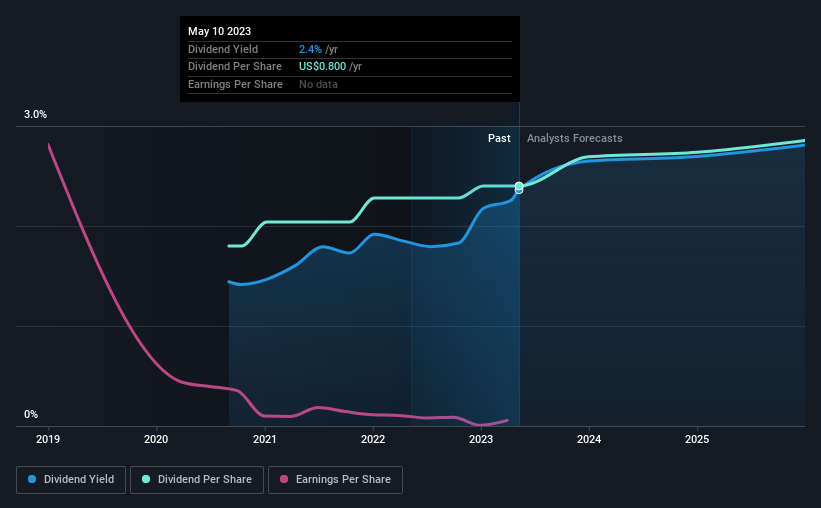- United States
- /
- Pharma
- /
- NasdaqGS:RPRX
Royalty Pharma's (NASDAQ:RPRX) Upcoming Dividend Will Be Larger Than Last Year's

Royalty Pharma plc's (NASDAQ:RPRX) dividend will be increasing from last year's payment of the same period to $0.20 on 15th of June. This takes the annual payment to 2.3% of the current stock price, which is about average for the industry.
See our latest analysis for Royalty Pharma
Royalty Pharma's Earnings Easily Cover The Distributions
Solid dividend yields are great, but they only really help us if the payment is sustainable. At the time of the last dividend payment, Royalty Pharma was paying out a very large proportion of what it was earning and 130% of cash flows. This is certainly a risk factor, as reduced cash flows could force the company to pay a lower dividend.
Analysts expect a massive rise in earnings per share in the next year. If recent patterns in the dividend continue, we could see the payout ratio reaching 10% which is fairly sustainable.

Royalty Pharma Doesn't Have A Long Payment History
The company has maintained a consistent dividend for a few years now, but we would like to see a longer track record before relying on it. Since 2020, the dividend has gone from $0.60 total annually to $0.80. This means that it has been growing its distributions at 10% per annum over that time. Royalty Pharma has been growing its dividend quite rapidly, which is exciting. However, the short payment history makes us question whether this performance will persist across a full market cycle.
The Dividend Has Limited Growth Potential
Some investors will be chomping at the bit to buy some of the company's stock based on its dividend history. Unfortunately things aren't as good as they seem. Royalty Pharma's earnings per share has shrunk at 50% a year over the past three years. This steep decline can indicate that the business is going through a tough time, which could constrain its ability to pay a larger dividend each year in the future. However, the next year is actually looking up, with earnings set to rise. We would just wait until it becomes a pattern before getting too excited.
The Dividend Could Prove To Be Unreliable
In summary, while it's always good to see the dividend being raised, we don't think Royalty Pharma's payments are rock solid. The payments are bit high to be considered sustainable, and the track record isn't the best. Overall, we don't think this company has the makings of a good income stock.
Investors generally tend to favour companies with a consistent, stable dividend policy as opposed to those operating an irregular one. However, there are other things to consider for investors when analysing stock performance. For instance, we've picked out 5 warning signs for Royalty Pharma that investors should take into consideration. If you are a dividend investor, you might also want to look at our curated list of high yield dividend stocks.
New: AI Stock Screener & Alerts
Our new AI Stock Screener scans the market every day to uncover opportunities.
• Dividend Powerhouses (3%+ Yield)
• Undervalued Small Caps with Insider Buying
• High growth Tech and AI Companies
Or build your own from over 50 metrics.
Have feedback on this article? Concerned about the content? Get in touch with us directly. Alternatively, email editorial-team (at) simplywallst.com.
This article by Simply Wall St is general in nature. We provide commentary based on historical data and analyst forecasts only using an unbiased methodology and our articles are not intended to be financial advice. It does not constitute a recommendation to buy or sell any stock, and does not take account of your objectives, or your financial situation. We aim to bring you long-term focused analysis driven by fundamental data. Note that our analysis may not factor in the latest price-sensitive company announcements or qualitative material. Simply Wall St has no position in any stocks mentioned.
About NasdaqGS:RPRX
Royalty Pharma
Operates as a buyer of biopharmaceutical royalties and a funder of innovation in the biopharmaceutical industry in the United States.
Very undervalued with proven track record.
Market Insights
Community Narratives




